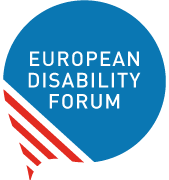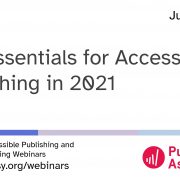George Kerscher Named NISO Fellow for Lifetime Achievement in Information Access
 Congratulations to Dr. George Kerscher, Chief Innovations Officer at The DAISY Consortium and Senior Advisor, Global Education and Literacy at Benetech, who was recently recognized as a Fellow by the National Information Standards Organization (NISO) for his lifetime of achievement. An internationally recognized leader in document access, he has been devoted to making published information fully accessible to persons with print disabilities since 1987. We had a chance to hear from George about what this honor means to him and how people with reading barriers can be better served across industries and disciplines going forward.
Congratulations to Dr. George Kerscher, Chief Innovations Officer at The DAISY Consortium and Senior Advisor, Global Education and Literacy at Benetech, who was recently recognized as a Fellow by the National Information Standards Organization (NISO) for his lifetime of achievement. An internationally recognized leader in document access, he has been devoted to making published information fully accessible to persons with print disabilities since 1987. We had a chance to hear from George about what this honor means to him and how people with reading barriers can be better served across industries and disciplines going forward.
Q: What does being named a NISO Fellow mean to you?
GEORGE: I have worked with NISO for more than 20 years, and most of that work has been in the library sector. NISO is also a pathway for the US to contribute to international standards, and I have participated in those activities as well. Most recently, ISO (an independent, non-governmental international organization) has approved the EPUB Accessibility Conformance and Discovery specification, and I participated through NISO in that work.
Being named a NISO Fellow is a great honour, and, being blind, I feel this reflects the change in society toward inclusion. People with print disabilities must be considered as we design information systems and standards.
Q: After achieving this distinguished honour through your work and accomplishments, what is the next critical problem that needs to be addressed regarding accessibility?
GEORGE: There is a lot more to do in access to information. Yes, the publishing industry has really stepped up to the accessibility plate, but there are still many publishers who need to embrace the principles of born accessible publications, meaning ebooks that have accessibility features built in from the start. Furthermore, society in general needs to be producing born accessible publications as a part of the normal process of document creation. I understand that Ph.D. students are now starting to produce their theses as accessible publications. This trend needs to be pushed down to all college students, and then down to high schools and into elementary schools. As soon as students start to produce materials for other students, they should make sure all students can read and consume what they produce. I can envision seventh graders creating documents which they share, and some of the students read them with the read aloud function and text highlighting as it is spoken. Once the features of accessibility are generally understood, they will become commonplace.
Q: How do people know if a title will be accessible?
GEORGE: In a born accessible EPUB, accessibility metadata is embedded using the schema.org vocabulary. Publishers are also including accessibility metadata using ONIX. The Publishing Community Group at the World Wide Web Consortium (W3C) is finishing up a user experience guide for translating the technical metadata to a user-friendly set of information. VitalSource has already implemented this in their catalogue, which means people can decide if the title will work for them, or if it would be a good option for a course. We need to promote this approach of exposing accessibility everywhere, including library systems and search engines.
Q: What’s next for areas such as accessible math standards?
GEORGE: All browsers and reading systems need to support MathML natively. Screen readers used by blind users have supported MathML for years, but until browsers and reading tools provide correct visual presentation of equations written in MathML, it will not be accepted. I expect that read aloud functions will present spoken math correctly and highlight the expression as it is spoken. If we can figure out how to have a car drive itself, we should be able to have math made fully accessible. While reading math correctly is the first step, doing math must also be fully accessible. Interestingly, it was the National Science Foundation (NSF) that first provided me with a tiny grant to work on accessible math back in 1989, and this problem is still not solved.
Q: How can professionals in publishing, education, technology, and other disciplines work together to better serve people with reading barriers?
GEORGE: Born accessible documents and publications are at the core of a change in the information society to be fully inclusive. Authors and publishers must embrace the born accessible movement. Authoring tools must include accessibility checkers, like Word does today, MathML, and features to add alt text to images and provisions for extended descriptions. The reading systems and apps must be fully accessible and tested, and the work at epubtest.org is a good example of the testing. Schools and institutions of higher education must buy born accessible ebooks that are third-party certified, as Voluntary Product Accessibility Templates (VPAT) may say all the right things but do not prove that the book is accessible.
About George Kerscher
George Kerscher, PhD, is the Chief Innovations Officer for the DAISY Consortium and served as the President of the International Digital Publishing Forum (IDPF). An internationally recognized leader in document access, he has been devoted to making published information fully accessible to persons with print disabilities since 1987. He coined the term “print disabled” to describe people who cannot effectively read print because of a visual, physical, perceptual, developmental, cognitive, or learning disability. A tireless advocate, George believes that access to information is a fundamental human right and properly designed information systems can make all information accessible to all people. He is the Director Emeritus at Guide Dogs for the Blind and in 2012 was honoured at the White House as a Champion of Change for leading innovation in the fields of science, technology, engineering, and math for people with disabilities. George and his guide dog Kroner graduated from Guide Dogs for the Blind in July, 2015.
About NISO
The National Information Standards Organization is a not-for-profit membership organization that identifies, develops, maintains, and publishes technical standards to manage information.
This article has been cross-posted with kind permission of Benetech, where George is a Senior Advisor. Our thanks to Carrie Motamedi, the author of this interview. George is also the Chief Innovations Officer at The DAISY Consortium and you can read more about the NISO Award at our DAISY news piece.




